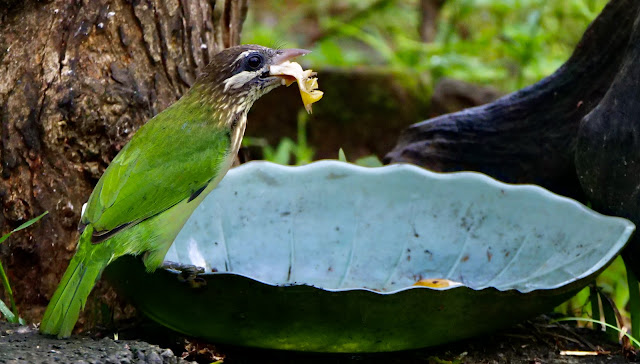The first part of my exploration at the feeding station after the monsoon receded, started about three months ago was: how to help Bulbuls and Barbets to feed together. That took about six weeks of different experiments.
One way I could facilitate that was by distributing fruits in three plates so that they did not have to crowd around one bowl. The Bulbuls arrived earlier than the Barbets and if they were given enough feed, they were less intrusive when the Barbets arrived.
The Barbets are gregarious by nature and would take large chunks of food at one time and would fly away sometimes with one banana.
The Bulbuls feeling threatened by this was partly overcome with more food spread out in three plates. The Bulbuls were happier if they found food in the evening time as well.
The next plan was to let the Barbets and squirrel feed together. The squirrels avoided Barbets.
I watched a squirrel wanting to feed from the feeding bowl. Mostly the squirrel came when there were no birds around.
The photos below would give a narration of the sequence of the experiment of how a squirrel got familiar to feed with Barbets.
On one occasion in the morning, I watched a squirrel making its decent towards the feeding bowl, slowly, taking extra caution to watch the reaction of the Barbet. In the following five photographs, there was one Bulbul next to the Barbet, which might have prompted the squirrel to take a chance. Bulbuls are comfortable with squirrels.
When the Bulbul moved away, the squirrel and the Barbet were alone. The sixth photo below is the turning point in this interesting sequence of a squirrel learning to co-feed with a Barbet. The squirrel with its tail flexed over its body, which might be an indication of anxiety or stress moved towards the edge of the bowl, in attempt to move to safety, when one Barbet alone was present.
At this juncture another Barbet arrived. Now the squirrel was between two Barbets and the squirrel relocated itself in the bowl! However the tail of the squirrel was flexed over its back still indicating anxiety or stress.
To have been able to see them together was a message that the squirrel and the Barbets have a different equation now.

However that did not fully resolve the conflicting behaviour between Barbets and squirrel. That could be resolved, by having a plate of millets and nuts that squirrel would feed on, which the Bulbuls or Barbets were not fond of.
The anxiety of not getting enough food to feed on, was removed as a reason for stressful and intimidating behaviour between birds.
Now the feeding station is a place where the regular birds and squirrel have got used to share and communicate around the morning meal.
The squirrel which normally had enormous fun chasing Myna between branches of trees looked settled in the last photo above to co-feed with a Myna.
Now it is considerably less to see birds who are residents or regular visitors in the garden, chasing each other during the day. The feeding time behaviour settled suspicion of each other and the far of denial of food.
This is a story of helping birds and squirrel to receive each other and belong to be more fraternal.
While the above experiment was going on to foster peace between birds in our garden, the aggression by Israel and Russia were continuing to put the future peace process in the world under the auspices of the United Nations Organisation in serious dysfunction.
I happened to re read some chapters of the book, Wisdom At Work, the making of a modern elder by Chip Conley.
Usually people of my age are referred to as the elderly. The suggestion of the author about being an elder fascinated me. "It is time to liberate the term elder from the word elderly. Elderly solely refers to years lived on the planet. Elder refers to what one has done with those years. Many people age without synthesizing wisdom from their experience. But elders reflect on what they have learned and incorporate it into the legacy they offer younger generation...Society has historically been dependent upon our elders, who have been of service to the young" (p12)
When Chip suggests that "teaching and learning are symbiotic" (p100), the role of an elder is redefined to be in the learning edge. All learning starts by a question. "The root word of question is quest. And through the process of reflection, every question can be a quest, a journey of self-discovery, the facilitator of a sojourning uncharted territory".
The proposal Chip made that all questions ought to lead to a quest, an appreciative inquiry, clicked with me. "Human systems grow in the direction of what they persistently ask questions about, and this propensity is strongest and most sustainable when means and ends of inquiry ar positively co-related" (p98).
Chip while commenting about Socrates suggested that he turned "the act of inquiry into art form, played the role of a perpetual student and modelled it for his younger mentees. He blurred the distinction between who was learning and who was teaching and, as such, he appeared less like the wise old man, but more like a mature, fully baked version of what his young students aspired to be"(p99).
I closed my years of work in Child development a year ago. Now, ordinary events taking place around me become a quest to discover, describe and celebrate.
Why birds and squirrel quarrel over food was a quest, which at the end of three months is less of a mystery than before!
What a calling it is to be at the edge of learning to become an elder!
M.C.Mathew (text and photo)













No comments:
Post a Comment